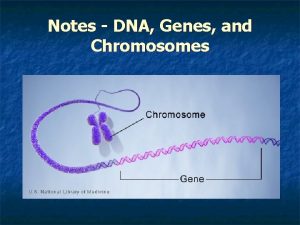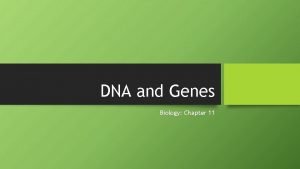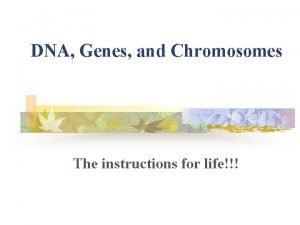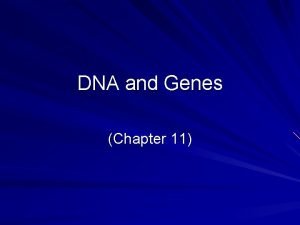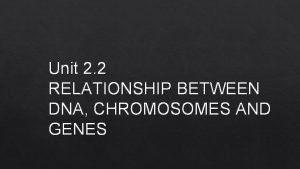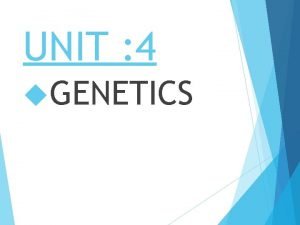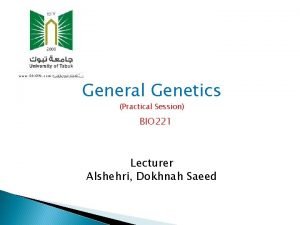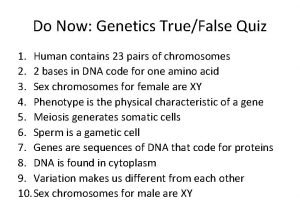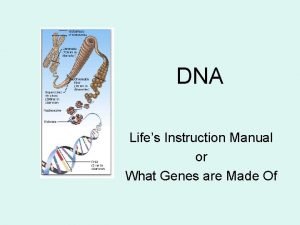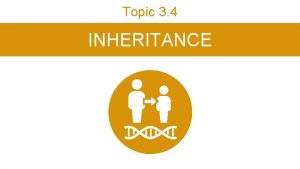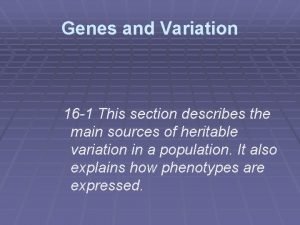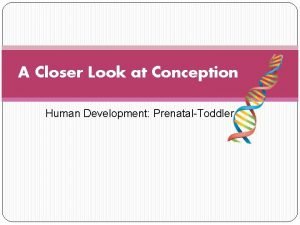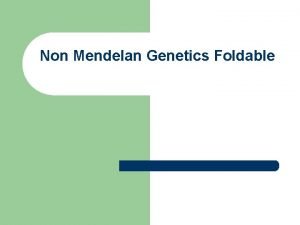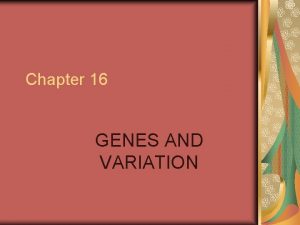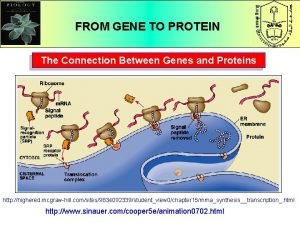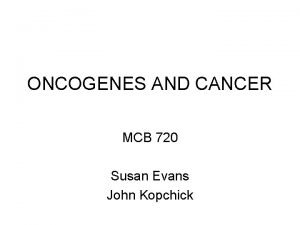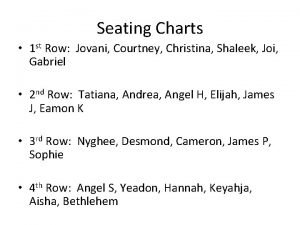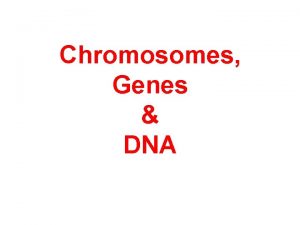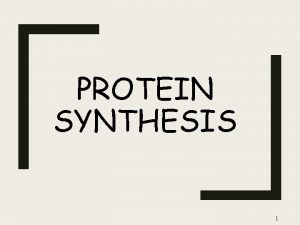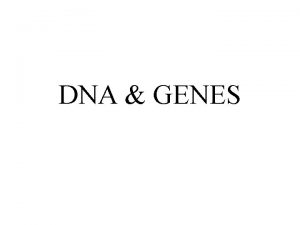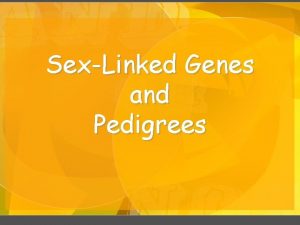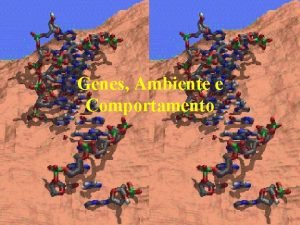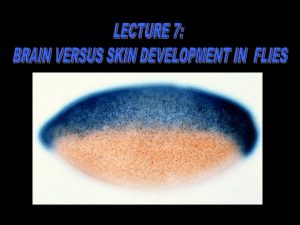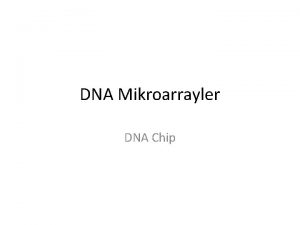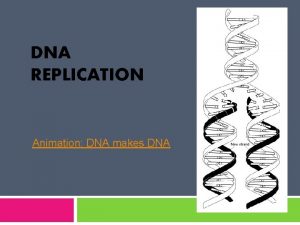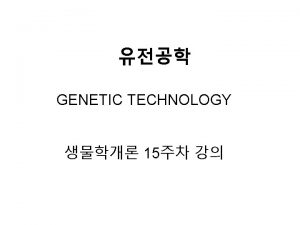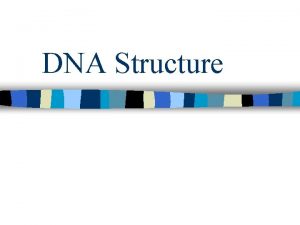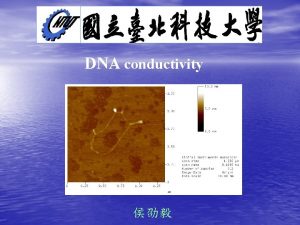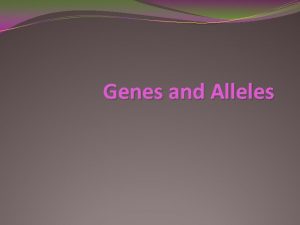DNA and The Language of Life Genes are











































- Slides: 43

DNA and The Language of Life

Genes are Made of DNA • Scientist discovered that DNA was a chemical inside the nucleus • Experiments were by Biologist: – Frederick Griffith – Oswald Avery – worked on Griffith’s experiments – Worked on bacteria to prove DNA was the reason for heredity. Oswald Avery 1944 Frederick Griffith 1928

Genes are Made of DNA • Further experiments by: – Alfred Hershey – Martha Chase • Worked with viruses to support Avery’s work

Genes are Made of DNA Virus – a package of nucleic acid wrapped in protein • Not made of cells • They can only reproduce by infecting a living cell Bacteriophage – a virus that infects bacteria

Nucleic Acids The Building Blocks of DNA Deoxiribonucleic Acid – this where genetic information is stored • DNA is a kind of nucleic acid, a polymer built from monomers called nucleotides Ribonucleic Acid (RNA) – another group of nucleotides, plays a role in protein synthesis. Nucleotides – are the building blocks (monomer) of nucleic acid polymer • Only 4 types of nucleotides make – up DNA

DNA - Nucleotides • Each DNA molecule has three parts:

DNA - Nucleotides Nitrogenous Base – 4 nucleotides found in DNA differ only in their nitrogenous bases Pyrimidines: single ring structure • Thymine (T) • Cytosine (C) Purines: double ring structure • Adenine (A) • Guanine (G)

DNA - Strands Nucleotides are joined by covalent bonds • Nucleotides are joined by covalent bonds – Connect one nucleotide to the phosphate group of the next – This pattern (Sugar-Phosphate-Sugar. Phosphate) • This is called Sugar – Phosphate Backbone – Nitrogenous bases (AG ; CT) line – up along this backbone – Nucleotides of a nucleic acid polymer can combine in many different sequences • Sequences are essentially unlimited

DNA - Structure • During the 1950’s scientist Rosalind Franklin produces using an X-ray (photograph) called : – X-ray Crystallography – Provided clues as to the shape and dimensions of the DNA molecule

The Double Helix • At more or less the same time scientist: – James Watson – Francis Crick • Using Franklin’s X-ray crystalography to provide clues to their discovery Double Helix – Model created by Watson and Crick; in which two strands of nucleotides wound about each other • Sugar phosphate backbones on the outside; Nitrogenous base on the inside.

The Double Helix

Complementary Base Pairs Base Pairing Rules A with T C with G • AT CG (Coral Gables)

DNA Replication • When a cell divides; a complete set of genetic instructions are created for each cell • Genetic material uses the template principle to make more DNA • Watson and Crick’s model for DNA allowed for the hypothesis of specific base pairing – A–T – C-G – If you know one strand of DNA you can determine the sequence on the other

DNA Replication During DNA copying: • Two strands of the double helix separate – Each strand acts like a picture negative • Nucleotides line up one at a time across the existing strand (as per base pairing rule) • Enzymes link the nucleotides together to form two new DNA strands Called Daughter Strands

DNA Replication

DNA Replication • More than a dozen enzymes are involved in DNA replication DNA Polymerases – Name of enzymes involved in DNA replication • Make covalent bonds between nucleotides of the new DNA strand – This happens really fast and it is really accurate • An error occurs in only one of a billion nucleotides DNA Polymerases

DNA Replication Origins of Replication - Specific sites where replication begins • The copying occurs outward in both directions creating replication bubbles. Daughter Strands grow on the inside

DNA Replication • In Eukaryotic Cells this can occur at the same time in different location • They eventually join. • This shortens replication time.

DNA Replication DNA replication occurs before cell division This ensures that cells carry the same genetic information This is also the method for inheritance.

Information for Making Protein • The molecular basis for phenotype (physical characteristics) lies in proteins “One Gene-One Enzyme” Hypothesis • One gene dictates the production of a specific enzyme • Hypothesis developed by geneticists George Beadle and Edward Tatum in the 1940’s Since then the hypothesis has evolved to: “one gene – one polypeptide”

DNA to RNA = Protein • As we know a gene is a sequence of bases along DNA chain – A gene is like a sentence • Specific strings of bases make-up a gene sentence

RNA (ribonucleic acids) • Any nucleic acid whose sugar is ribose rather than deoxyribose (DNA) • Another difference is that the Nitrogenous Base Thymine is replaced by Uracil (U) – Similar to thymine – Also Pair with Adenine • RNA forms single strands NOT a double helix (like DNA) – RNA can twist

RNA Transcription – The process of converting a DNA sequence to a form a single stranded RNA molecule. • RNA molecule leaves the nucleus and is involved with the making of protein

RNA Genetic Translation – Converts nucleic acid language into amino acid language Codon – A 3 – Base “word” that codes for one amino acid • This is how the flow of information from gene to protein is based on • Several codons form a sentence – that translates into polypetide

Triplet Code • There are specific codons to represent amino acid – Some amino acids are coded by more than one codon • But no codon represents more than one amino acid

Triplet Code • There is also a code for stop – These come at the end of a sequence • There are sequence that do not code form an amino acids – This coding is shared by ALL organisms (almost all) • Evidence of Evolution? ? ?

From Gene to Protein Transcription: DNA RNA Three Types of RNA messenger RNA (m. RNA) • Transcribed from a DNA template – Only one DNA strand serves as a template forming m. RNA

From Gene to Protein - Steps 1 st – DNA strand separates – This is where transcription will start 2 nd – RNA bases pair with complementary DNA bases (same as DNA replication, except Uracil)

From Gene to Protein RNA Polymerase – An enzyme; links RNA nucleotides together. • Still in second step; specific sequences of DNA nucleotides tell polymerase where to begin and end the transcribing process RNA Polymerase

From Gene to Protein Introns – non-coding regions in m. RNA • Only found in eukaryotic cells (most plants and animals) Exons – parts of m. RNA translated or expressed. • Before RNA leaves the nucleus the introns are removed and exons are joined together RNA Splicing – the process of removing introns and joining exons

From Gene to Protein Translation: RNA to Protein • Requires enzymes and ATP Transfere RNA (t. RNA) – translates the 3 – Letter codons of m. RNA to the amino acids that make up proteins.

From Gene to Protein - Translation Anticodon • Located at one end of the folded t. RNA molecule – It is a specific triplet of bases – Are complementary (or matched up with) a specific codon in m RNA • Recognition follows base pair rules (AU / CG) • At the other end is the site where a particular amino acid recognizes both t. RNA and its amino acid partner and links both together. Requires

From Gene to Protein - Translation Ribosome – coordinates the functioning of m. RNA and t. RNA Made of Two Subunits: Both made of proteins and r. RNA (ribosomal) r. RNA – acts like a “vise”; holds m. RNA and t. RNA molecules close together. P - Site and A – Site P – Site - a location on the t RNA molecule that allows for the polypeptide strand to hold together. A – Site – a location on the t. RNA molecule that allows for amino acids to hold together. • Ribosomes connect Amino Acid to polypeptide chain

The Process 1 st Step in Translation • All parts needed are brought together – – m. RNA First t. RNA with amino acid attached Two subunits of a ribosome The start codon AUG Next Step • Amino Acids are added one by one to the chain of amino acids. • Each addition occurs in a 3 -step process – Continues till you reach a stop codon – UAA Do not code – UAG for amino acid – UGS

The Process - continued Finally • The complete polypeptide (several 100 amino acids) is set free by hydrolysis from t. RNA • A single ribosome can make an average polypeptide in less than a minute. – This is happening all over the cell at the same time.

Protein Synthesis

Mutations

Mutations Any change in the nucleotide sequence of DNA They can involve large regions of a chromosome or just a single nucleotide pair

Mutations Two Catagories of Mutations 1. Base Substitution – the replacement of one base or nucleotide with another • Usually causes no change to the protein • But sometimes change results in a change that affects protein function – Sometime drastically • Because several amino acids have more than one codon it makes it possible that a mutation have no effect on a protein

Mutations - Base Substitution Silent Mutation – a mutation to DNA causes m. RNA codon to change from GAA to GAG (no change in protein • Some changes for amino acids have similar chemical properties – THUS: No Change

Mutations 2. Base Insertions or Deletion • Has a more significant effect • Because m. RNA is read as a series of triplet grouping, adding or subtracting – Will alter grouping of genetic message

Mutations - Base Insertions or Deletions Causes: • Mutations may occur when errors are made during DNA replication or when errors are made during chromosome cross-over Mutagens – a physical or chemical agent that cause mutations • High energy radiation (x-rays and uv rays) • One type of chemical mutagen are chemicals that are similar to normal DNA bases but causes incorrect base-pairing

Mutations • Can be harmful • Can be helpful in certain environments • If mutation is present in gametes it can be passed on to its offspring • Mutations are the ultimate source of genetic diversity.
 Mikael ferm
Mikael ferm Linked genes and unlinked genes
Linked genes and unlinked genes Polygenic inheritance
Polygenic inheritance Factors of 15
Factors of 15 Chromosome vs dna vs gene
Chromosome vs dna vs gene Chapter 11 dna and genes
Chapter 11 dna and genes Dna, genes and chromosomes relationship
Dna, genes and chromosomes relationship Dna and genes chapter 11
Dna and genes chapter 11 What is the relationship between dna chromosomes and genes
What is the relationship between dna chromosomes and genes Dna rna protein synthesis homework #2 dna replication
Dna rna protein synthesis homework #2 dna replication Genes chromosome
Genes chromosome Dna genes
Dna genes Dna genes
Dna genes Dna chromosomes genes diagram
Dna chromosomes genes diagram Coding dna and non coding dna
Coding dna and non coding dna Life instruction manual
Life instruction manual Replication fork
Replication fork Bioflix activity dna replication lagging strand synthesis
Bioflix activity dna replication lagging strand synthesis Enzyme involved in dna replication
Enzyme involved in dna replication Dominant versus recessive
Dominant versus recessive Evolution of populations section 16-1 genes and variation
Evolution of populations section 16-1 genes and variation Learn genetics utah karyotype
Learn genetics utah karyotype Genetics is the study of heredity
Genetics is the study of heredity 16-1 genes and variation
16-1 genes and variation Evolution of populations section 16-1 genes and variation
Evolution of populations section 16-1 genes and variation Section 16-1 genes and variation
Section 16-1 genes and variation Dominant and recessive genes
Dominant and recessive genes Genetics foldable
Genetics foldable Section 16-1 genes and variation
Section 16-1 genes and variation What is the connection between genes and proteins
What is the connection between genes and proteins Difference between proto oncogene and oncogene
Difference between proto oncogene and oncogene Flocabulary genes and heredity answer key
Flocabulary genes and heredity answer key Hình ảnh bộ gõ cơ thể búng tay
Hình ảnh bộ gõ cơ thể búng tay Ng-html
Ng-html Bổ thể
Bổ thể Tỉ lệ cơ thể trẻ em
Tỉ lệ cơ thể trẻ em Gấu đi như thế nào
Gấu đi như thế nào Glasgow thang điểm
Glasgow thang điểm Hát lên người ơi
Hát lên người ơi Môn thể thao bắt đầu bằng chữ đua
Môn thể thao bắt đầu bằng chữ đua Thế nào là hệ số cao nhất
Thế nào là hệ số cao nhất Các châu lục và đại dương trên thế giới
Các châu lục và đại dương trên thế giới Công của trọng lực
Công của trọng lực Trời xanh đây là của chúng ta thể thơ
Trời xanh đây là của chúng ta thể thơ




